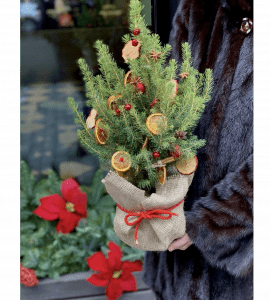The main New Year’s symbol in the culture of the Slavic countries is a Christmas tree decorated with colorful lights, bright toys and tinsel. Foreign New Year’s films – “Home Alone”, “Christmas Story”, “The Grinch Stole Christmas” – also demonstrate a fir tree as a New Year tree. Because of this, it may seem as if the whole world is celebrating the change of the year with spruce. But this is not so: the coniferous tree we are accustomed to in different countries is replaced by deciduous plants, mini-versions of trees, individual branches, wreaths, compositions in the form of bouquets or potted flowers. The result is the same festive and atmospheric!
In countries with hot climates, conifers are not very popular, therefore, a palm tree is considered a symbol of the New Year holidays. This tree is decorated in Brazil, Mexico and Cuba. Cubans also put gifts under the araucaria, a small coniferous plant with flat branches. Cacti are also decorated on New Year’s Eve in Cuba.
Australia and New Zealand consider Metrosideros a New Year tree. Lush red inflorescences consisting of thin needles grow on its branches. This gives the tree a festive look even without additional decorations. Gifts in these countries are hidden in multi-colored socks hung on the metrosideros.
In the culture of many countries, the New Year tree becomes a reflection of traditional values. In Sudan, walnut is dressed up for the holiday – it is considered a symbol of wealth and health. Nicaragua’s New Year’s mascot is a coffee tree, a symbol of wealth and fertility. The Greeks decorate a pomegranate tree instead of a Christmas tree, and the pomegranates themselves, as a symbol of the coming of a new time, are always present in the house during the celebration.
In many countries, it is customary to make New Year’s compositions from small trees in pots. Inhabitants of Asia decorate with traditional ribbons kumquat (tangerine tree). The Israelis consider the Arizona cypress to be the country’s New Year symbol. A young cypress tree in a pot is bought before the holidays, and after they are over, the plant can be planted in the local area.
The Vietnamese use small bamboo trunks as a New Year tree. Several of these trunks are installed at the entrance to the house, decorating bamboo poles with dry leaves, clay figurines and kerosene lamps – according to popular belief, this design scares away evil spirits. Gifts are placed under trunks or tied directly to them.
In many countries, tree branches and wreaths from them are valued as New Year and Christmas attributes along with a Christmas tree. Especially wreaths, armfuls of branches and living garlands of plants are appreciated in the Catholic states.
The most striking example of traditional floral decor is a New Year’s wreath on the door. In Great Britain, holly (holly) is used for this: its leaves of a special shape symbolize the crown of thorns of Christ, and the red berries – the blood of the Savior. Holly branches are also used for interior decoration: they are used to decorate the Christmas table, lamps, windows and stairs. Shops, malls, pubs and restaurants are also decorated with holly wreaths and individual branches.
Another symbol of the New Year and Christmas in modern Catholicism is mistletoe: according to legend, this plant is able to ward off evil spirits and bring good luck. There is an English tradition on the right to kiss under the mistletoe branches: if a girl accidentally finds herself under a Christmas decoration, the young man has the right to kiss her, just picking one berry from the branch. Because of this custom, the mistletoe Christmas decorations get their second name – the kissing branch.
European mistletoe (nuitsia) is a traditional home decoration in the already mentioned New Zealand. The plant species there blooms just in time for the end of December, and on Catholic Christmas New Zealanders and Australians give each other armfuls of yellow nuitsia blossoms.
In Europe, you can give a friend or relative flowers for the New Year, and there is nothing strange in this: thousands of people annually order the delivery of poinsettia to their home, office or other city. For the brightness and unusual shape of the upper leaves, this plant is called the Christmas star. Poinsettia pots and bouquets are traditional wishes for a Merry Christmas in America.
In Brazil, you can also get a flower – a Christmas cactus – as a New Year gift. We call this plant the Decembrist, because it blooms just in time for Christmas, and flowers are preserved throughout the New Year holidays.
The idea of giving New Year’s bouquets and wreaths to relatives and friends is gradually becoming popular outside of Europe. Winter collections of flowers create a festive atmosphere in the house, complementing the Christmas decor, and in small rooms, New Year’s compositions become a complete replacement for a Christmas tree.

